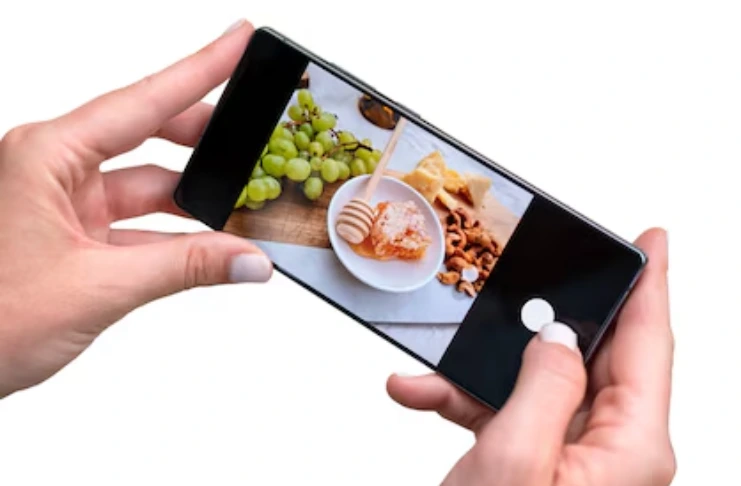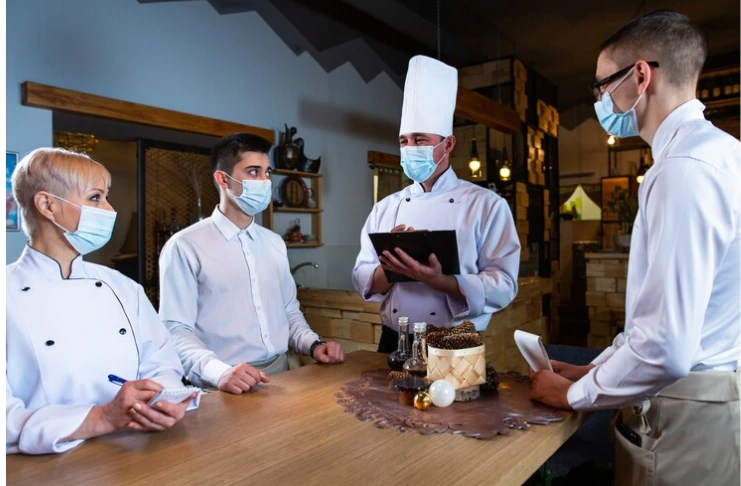
The advent of virtual reality (VR) and augmented reality (AR) revolutionized the restaurant industry, and it is anticipated that there will be an even greater technological fusion, bringing the world’s flavors closer to our senses. According to a research, the trend is expected to continue in Food and beverage market to Surpass USD 10.45 Billion by 2030 at a CAGR of 32.46% from 2022 to 2030.
Over the years, the sector has recorded the evolution from handwritten menus to digital tablets and from traditional kitchens to high-tech culinary labs. These technologies enhance dining aesthetics and improve operational efficiency and customer satisfaction. Restaurants leverage AR and VR to streamline kitchen operations, provide real-time feedback, and even offer virtual cooking classes. The possibilities are endless, and as VR and AR evolve, they promise to make dining out an even more magical and memorable culinary adventure.
Introduction to Augmented Reality
AR is a technology that overlays digital content such as images, animations, or text onto the real world in real-time. This technology enhances users’ perception of the physical environment by adding virtual elements. For example, AR can be experienced through smartphones, tablets, or AR glasses.
Restaurants can use AR to create interactive menus. Customers can scan items with their smartphones to see 3D visualizations of dishes. This helps diners get a better sense of portion sizes, ingredients, and presentation before ordering. In the subsequent sections, we will explore several other applications of AR in restaurants.
Introduction to Virtual Reality
VR creates a completely immersive, computer-generated experience by replacing the real world with a simulated environment. Users typically wear VR headsets that block out the physical world and transport them into a computer-generated setting where they can interact with the virtual objects and surroundings.
Restaurants can use VR to transport diners to different settings, such as a serene beach or a bustling cityscape, enhancing the ambiance and making the dining experience more exciting. For instance, McDonald’s uses VR to provide customers with a 360-degree virtual tour of its farms, showing the origins of its ingredients.
AR and VR Applications in the Restaurant Industry
These technologies are transforming the restaurant industry by offering unique and innovative ways for restaurants to improve customer engagement and streamline operations. Some applications include:

- Interactive AR Menus: Restaurants use AR to create interactive menus, where customers can scan menus with their smartphones to see 3D visualizations of dishes. The user can see the food in its actual form and size. Restaurants can even add a video of the cooking process or other information.
For instance, Pizza Hut uses AR menus that allow customers to see a virtual representation of their pizza before placing an order. McDonald’s, Bareburger, La Tagliatella, Denny’s Diner, and other restaurants have long successfully used AR menus. - Order Customization with AR: AR allows customers to personalize their meals by customizing ingredients, portion sizes, or cooking methods. This level of customization enhances the dining experience and caters to individual preferences.
For instance, Domino’s launched the “New Pizza Chef” program, which allows diners to make their pizza and thus customize the order. Similarly, consumers can customize their sushi, salads, burgers, etc. - AR-Based Staff Training: Restaurants can use AR for staff training in innovative and effective ways, significantly elevating the overall customer experience. Using AR, virtual restaurant environments can be created where staff can practice their roles. Waitstaff can learn how to set tables, take orders, and serve food in a simulated dining room, while chefs and kitchen staff can use AR to practice cooking techniques. This hands-on training can enhance real-world performance and boost confidence.
AR can also successfully teach staff about wine pairings and cocktail preparation. For kitchen staff, AR can provide step-by-step guidance for preparing dishes, with overlays showing exact measurements, cooking times, and plating instructions for each menu item. This feature helps maintain consistency in food quality and presentation. - Increase customer engagement: Integrating AR and VR transform the traditional dining experience by creating engaging experiences that attract and retain customers. Some restaurants use AR games or interactive storytelling to entertain guests while they wait for their meals. For example, diners can virtually explore a vineyard while sipping wine.
The advantages of AR include creating multi-sensory dining experiences, adding a layer of entertainment, and enhancing customer engagement. This also boosts brand loyalty and creates a dining experience that helps you stay ahead of the competition. - Personalized Marketing: AR and VR supports highly personalized marketing campaigns that engage customers in new ways. Users can scan AR-enabled packaging to unlock exclusive content like video recipes, special offers, or Interactive games. This innovative approach enhances brand engagement and encourages customers to Interact with products more deeply.
For instance, if you plan to launch a new dessert, you can design a 3D dessert model, demonstrate the dish from all sides and in a cut, and show the cooking process using AR to get your customers to order it. A study reports that 22% of operators plan to devote resources to augmented reality for training or marketing campaigns, and 16% say they’ll invest in artificial intelligence (AI) integration.

Benefits of AR and VR in the Restaurant Industry
AR and VR benefit restaurant businesses by revolutionizing customer experience and operational efficiency. Here’s a look at the key benefits:
1. Improved Menu Presentation: When menus are poorly crafted, customers often find it challenging to visualize dishes from text descriptions alone, leading to uncertainty and customer dissatisfaction.
- With AR, restaurants can overlay digital images of menu items onto the real world, allowing customers to see 3D representations of dishes on their tables before ordering. This helps customers make more informed choices, increasing satisfaction and potentially higher average order values.
- Additionally, VR can create immersive experiences where customers can explore a virtual restaurant environment and view detailed, lifelike representations of menu items.
2. Efficient Staff Training: Staff training is crucial in the restaurant industry to ensure consistent service quality, enhance customer satisfaction, and maintain operational efficiency.

- Restaurants implementing AR technology can provide staff with real-time, step-by-step instructions and visual aids during training, improving their learning experience.
- Restaurants can use VR to train staff in a simulated environment, providing hands-on experience without the pressure of a real-world setting. This can improve efficiency and service quality. For instance, VR can help chefs practice making new dishes without using up ingredients, and waitstaff can visualize meals to describe them to customers better.
3. Streamlined Operations: Poor streamlined operations in the restaurant industry can lead to inefficiencies, inconsistent food quality, and reduced customer satisfaction.
- By integrating AR, restaurants can provide kitchen staff with precise cooking instructions and visual guides, ensuring consistency in food preparation and presentation.
- VR can be used to design and optimize kitchen layouts and workflows, helping to identify the most efficient setups and processes before implementing them in the real world.
4. Improved Decision-Making: Effective decision-making in restaurant management is essential for optimizing operations and ensuring long-term profitability.
- AR can collect and analyze customer data, such as preferences and behaviors, providing valuable insights for menu adjustments and targeted marketing to help restaurant managers make better decisions.
- VR can simulate different restaurant layouts, concepts, and customer experiences, allowing managers to test and refine ideas before making costly changes.
5. Customer Loyalty Programs: Engaging and interactive loyalty programs in restaurants can drive repeat visits and build a loyal customer base, and increases revenue.

- With AR, restaurants can make loyalty programs more interactive and engaging by allowing customers to unlock rewards through AR experiences, such as virtual scavenger hunts or games. Other benefits include:
- Personalized offers: Customers can receive AR-based notifications about special deals or rewards near restaurants.
- Social sharing: Encouraging customers to share their AR experiences on social media fosters a sense of community and attracts new customers.
- Feedback and interaction: AR can engage customers in gathering feedback, such as through interactive surveys or virtual suggestion boxes.
- Targeted Marketing: The data collected through AR interactions can help restaurants create more targeted and effective marketing campaigns, further enhancing customer loyalty.
- VR can create immersive loyalty experiences, such as virtual tours of the restaurant or exclusive VR events for loyal customers, enhancing their connection to the brand.
Use Cases of Augmented Reality and Virtual Reality in Restaurants
1. Magnolia Bakery in NYC
Magnolia Bakery uses AR technology to enhance the customer experience by displaying virtual representations of cakes and other products in the store. When customers arrive, they receive an AR-based catering menu, allowing them to explore and visualize the items before purchasing. Customers may touch, feel, and investigate.
2. Walmart and Kraft
Walmart, a retail behemoth, and Kraft, a food behemoth, collaborated to provide the benefits of AR VR in restaurants to their respective client bases. Walmart has integrated AR and VR technologies to improve the shopping experience. For example, they use AR for virtual try-ons, allowing customers to see how clothing and home goods will look in real life before purchasing. This reduces returns and enhances customer satisfaction. Kraft has also used AR to create interactive experiences, such as scanning product packaging to access recipes and cooking tips.
3. Domino’s Pizza
Domino’s Pizza leverages AR through its app’s Pizza Chef function, allowing customers to customize and visualize their pizza creations in 3D. This feature helps customers see their pizzas’ size, texture, and ingredients before placing an order, making the ordering process more engaging and interactive.
Challenges and Considerations
Implementing AR and VR in restaurants can offer exciting opportunities but also comes with several challenges to consider:
1. Lack of Technological Components: Many restaurants may lack the hardware and software to support AR/VR technologies. This includes high-quality displays, VR headsets, and robust internet connectivity. Moreover, they also lack:
- Training: Patrons need training to use AR/VR. Some may know how to use it, while others will need assistance.
- Accessibility: AR in restaurants can be expensive and complex, making it hard for staff to operate without restrictions.
- Functionality: Some VR systems can’t manage movement and gestures, which can frustrate users.
2. Lack of Skill: Implementing and maintaining AR/VR systems requires specialized skills. Many restaurant staff may not have the technical expertise to operate these systems effectively and need additional training.
3. Cost: The initial AR/VR technology investment can be substantial. This includes the cost of hardware, software development, and ongoing maintenance. For smaller restaurants, these costs can be prohibitive.
4. Privacy Concerns: AR/VR applications often collect user preferences and behaviors data. Ensuring this data is handled securely and complying with privacy regulations is crucial to avoid potential breaches and maintain customer trust.
5. Balancing Authenticity: While AR/VR can enhance the dining experience, it’s essential to balance technology with the authentic, personal touch many customers expect in a restaurant setting. Over-reliance on technology might detract from the traditional dining experience.
Conclusion
The integration of augmented reality and virtual reality in the restaurant industry marks a revolutionary shift towards unparalleled customer experiences and operational efficiency. By leveraging these technologies, restaurants can create immersive dining atmospheres, streamline processes, and engage patrons innovatively. While several challenges exist, the potential benefits far outweigh these obstacles. As AR and VR evolve, they promise to enrich the culinary adventure and redefine what it means to dine out in the modern era. For restaurants willing to innovate, the future holds exciting opportunities to captivate and retain customers, making each meal an extraordinary experience.








